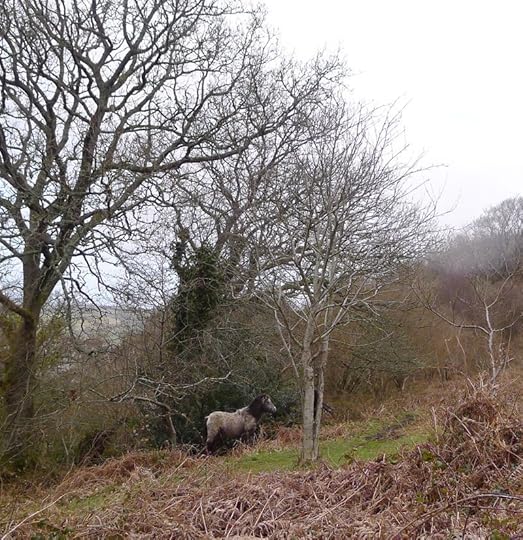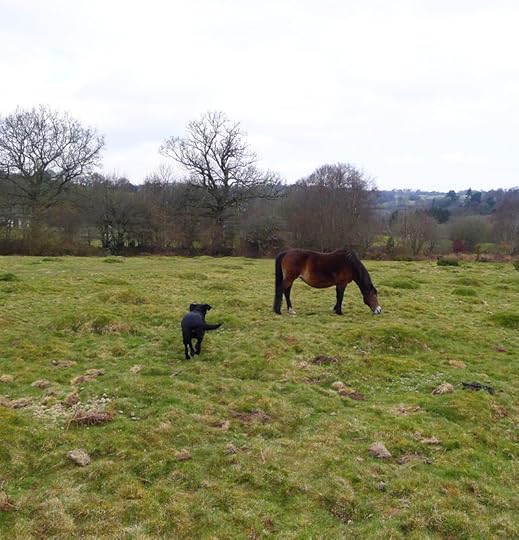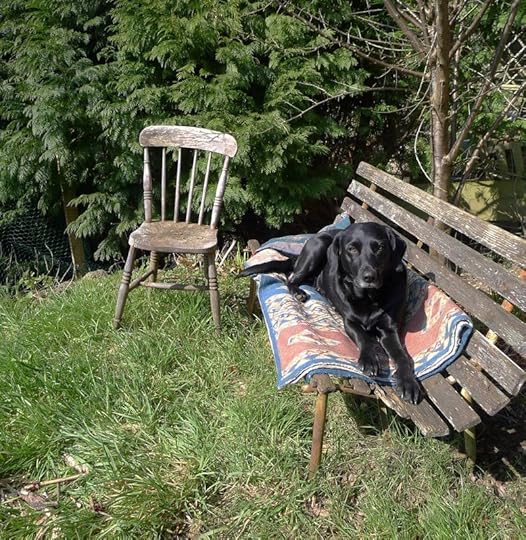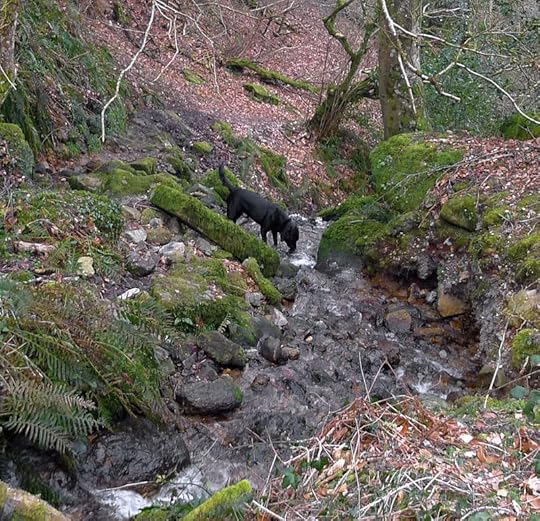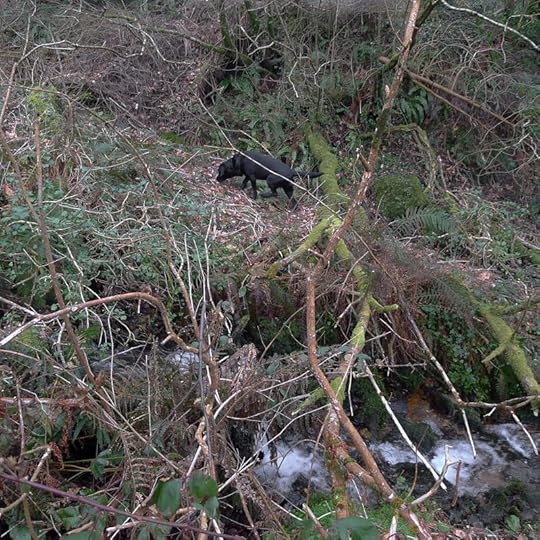Terri Windling's Blog, page 193
April 18, 2013
Facing fear, 4: On risk and uncertainty
From Mastering Creative Anxiety by Eric Maisel:
"Consider the process. All day long you are supposed to get things
right: drive on the correct side of the road, show up for appointments,
balance your checkbook, appropriately respond to your email, and so on.
Your whole day and your whole mind are aimed at not making mistakes, not
making messes, not getting yourself into trouble, avoiding unnecessary
risks, and looking right to the world. Then, somehow, [as an artist] you must shift
from that way of being and thinking to a radically different state, one
in which mistakes and messes are not only possible and probable but
downright guaranteed."
From Art & Fear by David Bayles and Ted Orland:
"Photographer Jerry Uelsmann once gave a slide lecture in which he showed every single image he had created in the span of one year: some hundred-odd pieces -- all of about ten of which he judged insufficient and destroyed without ever exhibiting. Tolstoy, in the Age Before Typewriters, re-wrote War & Peace eight times and was still revising galley proofs as it finally rolled onto the press. William Kennedy gamely admitted that he re-wrote his own novel Legs eight times and that 'seven times it came out no good. Six times it was especially no good. The seventh time out it was pretty good, though it was way too long. My son was six years old by then and so was my novel, and they were both about the same height.'
"It is, in short, the normal state of affairs. The truth is that the
finished piece of art which seems so profoundly right in its finished
state may earlier have been only inches or seconds away from collapse.
"In making art you need to give yourself room to respond authentically, both to your subject matter and to your materials. Art happens between you and something -- a subject, an idea, a technique -- and both you and that subject need to be free to move....Lawrence Durrell likened the process to driving construction stakes in the ground: you plant a stake, run fifty yards ahead and plant another, and pretty soon you know which way to go. E.M. Forester recalled that when he began writing A Passage to India he knew that the Malabar Caves would play a centrol role in the novel, that something important would surely happen there -- but he wasn't sure what it would be.
"Control apparently is not the answer. People who need certainty in
their lives are less likely to make art that is risky, subversive,
complicated, iffy, suggestive or spontaneous. What's really need is
nothing more than a broad sense of what you are looking for, some
strategy for how to find it, and an overriding willingness to embrace
mistakes and surprises along the way."
"The creative process is a process of surrender, not control." - Julia Cameron
"Writing is like driving at night in the
fog. You can only see as far as your headlights, but you can make the
whole trip that way." - E. L. Doctorow
"Living is a form of not being sure, not knowing what next
or how. The moment you know how, you begin to die a little. The artist
never entirely knows. We guess. We may be wrong, but we take leap after
leap in the dark." - Agnes de Mille
"Dancing is just discovery, discovery, discovery. As is all art." - Martha Graham
 Images: Two wild Dartmoor ponies who have separated from the herd and taken up residence on our rain-sodden hill. We meet them on our walks at down -- in the woods, on the hill, and grazing in the farmer's field below. We don't know how long they'll chose to stay...but right now, they seem quite content.
Images: Two wild Dartmoor ponies who have separated from the herd and taken up residence on our rain-sodden hill. We meet them on our walks at down -- in the woods, on the hill, and grazing in the farmer's field below. We don't know how long they'll chose to stay...but right now, they seem quite content.
April 17, 2013
Facing fear, 3: Stepping out of one's comfort zone
From Art & Fear by David Bayles and Ted Orland:
"Fears arise when you look back, and they arise when you look ahead.
If you're prone to disaster fantasies, you may even find yourself caught
in the middle, staring at your half-finished canvas and fearing both
that you lack the ability to finish it, and that no one will understand
it if you do.
"More often, though, fears arise in those entirely appropriate (and frequently recurring) moments when vision races ahead of execution. Consider the story of the young student -- well, David Bayles, to be exact -- who began piano studies with a Master. After a few months' practice, David lamented to his teacher, 'But I can hear the music so much better in my head than I can get it out through my fingers.'
"To which the Master replied, 'What makes you think that ever changes?'
"That's why they're called Masters. When he raised David's discovery
from an expression of self-doubt to a simple observation of reality,
uncertainty became an asset. Lesson for the day: vision is always ahead
of execution -- and it should be. Vision, Uncertainty, and
Knowledge of Materials are inevitabilities that all artists must
acknowledge and learn from: vision is always ahead of execution,
knowledge of materials is your contact with reality, and uncertainty is a
virtue."
"Conditions for creativity are to be puzzled, to concentrate, to accept conflict and tension, to be born every day, to feel a sense of self." - Erich Fromm
"Don’t be afraid to expand yourself, to step out of your comfort zone. That’s where the joy and the adventure lie.'' - Herbie Hancock
Facing fear, 3
From Art & Fear by David Bayles and Ted Orland:
"Fears arise when you look back, and they arise when you look ahead.
If you're prone to disaster fantasies, you may even find yourself caught
in the middle, staring at your half-finished canvas and fearing both
that you lack the ability to finish it, and that no one will understand
it if you do.
"More often, though, fears arise in those entirely appropriate (and frequently recurring) moments when vision races ahead of execution. Consider the story of the young student -- well, David Bayles, to be exact -- who began piano studies with a Master. After a few months' practice, David lamented to his teacher, 'But I can hear the music so much better in my head than I can get it out through my fingers.'
"To which the Master replied, 'What makes you think that ever changes?'
"That's why they're called Masters. When he raised David's discovery
from an expression of self-doubt to a simple observation of reality,
uncertainty became an asset. Lesson for the day: vision is always ahead
of execution -- and it should be. Vision, Uncertainty, and
Knowledge of Materials are inevitabilities that all artists must
acknowledge and learn from: vision is always ahead of execution,
knowledge of materials is your contact with reality, and uncertainty is a
virtue."
"Conditions for creativity are to be puzzled, to concentrate, to accept conflict and tension, to be born every day, to feel a sense of self." - Erich Fromm
"Don’t be afraid to expand yourself, to step out of your comfort zone. That’s where the joy and the adventure lie.'' - Herbie Hancock
April 16, 2013
Facing fear, 2: On courage and confidence
From Art & Fear by David Bayles and Ted Orland:
"The desire to make art begins early. Among the very young this is encouraged (or at least indulged as harmless) but the push toward a 'serious' education soon exacts a heavy toll on dreams and fantasies....Yet for some the desire persists, and sooner or later must be addressed. And with good reason: your desire to make art -- beautiful or meaningful or emotive art -- is integral to your sense of who you are. Life and Art, once entwined, can quickly become inseparable; at age ninety Frank Lloyd Wright was still designing, Imogen Cunningham still photographing, Stravinsky still composing, Picasso still painting.
"But if making art gives substance to your sense of self, the corresponding fear is that you're not up to the task -- that you can't do it, or can't do it well, or can't do it again; or that you're not a real artist, or not a good artist, or have no talent, or have nothing to say. The line between the artist and his/her work is a fine one at best, and for the artist it feels (quite naturally) like there is no such line. Making art can feel dangerous and revealing. Making art is dangerous and revealing. Making art precipitates self-doubt, stirring deep waters that lay between what you know you should be, and what you fear you might be. For many people, that alone is enough to prevent their ever getting started at all -- and for those who do, trouble isn't long in coming. Doubts, in fact, soon rise in swarms:
"I am not an artist -- I am a phony. I have nothing worth saying. I'm not sure what I'm doing. Other people are better than I am. I'm only a [student/physicist/mother/whatever]. I've never had a real exhibit. No one understands my work. No one likes my work. I'm no good.
"Yet viewed objectively, these fears obviously have less to do with art than they do with the artist. And even less to do with the individual artworks. After all, in making art you bring your highest skills to bear upon the materials and ideas you most care about. Art is a high calling -- fears are coincidental. Coincidental, sneaky and disruptive, we might add, disguising themselves variously as laziness, resistance to deadlines, irritation with materials or surroundings, distraction over the achievements of others -- indeed anything that keeps you from giving your work your best shot. What separates artists from ex-artists is that those who challenge their fears, continue; those who don't, quit. Each step in the artmaking process puts that issue to the test."
'It takes courage to grow up and become who you really are.'' - E.E. Cummings
"The most important thing is that you love what you are doing, and the
second that you are not afraid of where your next idea will lead." - Charles Eames
 Images: Dartmoor ponies on the village Commons, and Tilly heading home.
Images: Dartmoor ponies on the village Commons, and Tilly heading home.
Facing fear, 2
From Art & Fear by David Bayles and Ted Orland:
"The desire to make art begins early. Among the very young this is encouraged (or at least indulged as harmless) but the push toward a 'serious' education soon exacts a heavy toll on dreams and fantasies....Yet for some the desire persists, and sooner or later must be addressed. And with good reason: your desire to make art -- beautiful or meaningful or emotive art -- is integral to your sense of who you are. Life and Art, once entwined, can quickly become inseparable; at age ninety Frank Lloyd Wright was still designing, Imogen Cunningham still photographing, Stravinsky still composing, Picasso still painting.
"But if making art gives substance to your sense of self, the corresponding fear is that you're not up to the task -- that you can't do it, or can't do it well, or can't do it again; or that you're not a real artist, or not a good artist, or have no talent, or have nothing to say. The line between the artist and his/her work is a fine one at best, and for the artist it feels (quite naturally) like there is no such line. Making art can feel dangerous and revealing. Making art is dangerous and revealing. Making art precipitates self-doubt, stirring deep waters that lay between what you know you should be, and what you fear you might be. For many people, that alone is enough to prevent their ever getting started at all -- and for those who do, trouble isn't long in coming. Doubts, in fact, soon rise in swarms:
"I am not an artist -- I am a phony. I have nothing worth saying. I'm not sure what I'm doing. Other people are better than I am. I'm only a [student/physicist/mother/whatever]. I've never had a real exhibit. No one understands my work. No one likes my work. I'm no good.
"Yet viewed objectively, these fears obviously have less to do with art than they do with the artist. And even less to do with the individual artworks. After all, in making art you bring your highest skills to bear upon the materials and ideas you most care about. Art is a high calling -- fears are coincidental. Coincidental, sneaky and disruptive, we might add, disguising themselves variously as laziness, resistance to deadlines, irritation with materials or surroundings, distraction over the achievements of others -- indeed anything that keeps you from giving your work your best shot. What separates artists from ex-artists is that those who challenge their fears, continue; those who don't, quit. Each step in the artmaking process puts that issue to the test."
'It takes courage to grow up and become who you really are.'' - E.E. Cummings
"The most important thing is that you love what you are doing, and the
second that you are not afraid of where your next idea will lead." - Charles Eames
 Images: Dartmoor ponies on the village Commons, and Tilly heading home.
Images: Dartmoor ponies on the village Commons, and Tilly heading home.
April 15, 2013
Facing fear
I dislike the stereotype of the "suffering artist," for my best work springs from joy, not misery, and from working conditions that are calm, not chaotic. Nonetheless, I'd like to look at the dark side of creativity this week, as it's something so many of us have struggled through: the fear and anxiety that can manifest as as endless procrastination, or the inability to complete a project, or even, at its worst, complete creative paralysis. For me, this was more of a problem when one when I was younger, less confident, and less established in my work routines, but even today fear can suddenly appear and 'whup me longside the head' (as my Southern relatives used to say), particularly when I'm entering new creative territory...which, of course, we must regularly do as we stretch, grow, and explore our craft.
Here's dancer/choreograpger Twyla Tharp again, from her excellent book The Creative Habit:
"When I walk into [the studio] I am alone, but I am alone with my body, ambition, ideas, passions, needs, memories, goals, prejudices, distractions, fears.
"These ten items are at the heart of who I am. Whatever I am going to create will be a reflection of how these have shaped my life, and how I've learned to channel my experiences into them.
"The last two -- distractions and fears -- are the dangerous ones. They're the habitual demons that invade the launch of any project. No one starts a creative endeavor without a certain amount of fear; the key is to learn how to keep free-floating fears from paralyzing you before you've begun. When I feel that sense of dread, I try to make it as specific as possible. Let me tell you my five big fears:
1. People will laugh at me.
2. Someone has done it before.
3. I have nothing to say.
4. I will upset someone I love.
5. Once executed, the idea will never be as good as it is in my mind.
"There are mighty demons, but they're hardly unique to me. You probably share some. If I let them, they'll shut down my impulses ('No, you can't do that') and perhaps turn off the spigots of creativity altogether. So I combat my fears with a staring-down ritual, like a boxer looking his opponent right in the eye before a bout.
1. People will laugh at me? Not the people I respect; they haven't yet, and they're not going to start now....
2. Someone has done it before? Honey, it's all been done before. Nothing's original. Not Homer or Shakespeare and certainly not you. Get over yourself.
3. I have nothing to say? An irrelevant fear. We all have something to say.
4. I will upset someone I love? A serious worry that is not easily exorcised or stared down because you never know how loved ones will respond to your creation. The best you can do is remind yourself that you're a good person with good intentions. You're trying to create unity, not discord.
5. Once executed, the idea will never be as good as it is in my mind? Toughen up. Leon Battista Alberti, the 15th century architectural theorist, said, 'Errors accumulate in the sketch and compound in the model.' But better an imperfect dome in Florence than cathedrals in the clouds."
"Sometimes I think the difference between what we want and what we're afraid of is about the width of an eyelash.”
- Jay McInerney
Your thoughts?
Video and sketch above: Re-visiting Ryan Woodward's dance animation,"Thought of You," with music by The Weepies.
Post script: This was written and posted before I learned about the bombings in Boston,
which of course raises fears of a very different kind. My thoughts are
with friends and readers in Boston today (a city where I used to live,
and a city that I love) -- I hope you and are your loved ones are safe.
April 14, 2013
Tunes for a Monday Morning
I was so pleased when Lau, the folk trio from Scotland, won "Best Band of 2013" in the BBC Radio 2 Folk Awards (held in Glasgow in January)...for the third, or is it the fourth time now? Named after the Orcadian word for "natural light," the group consists of Kris Drever (guitar and vocals), Martin Green (accordion and piano), and Aidan O'Rourke (fiddle). And if their music wasn't already reason enough to love this band, I also appreciated the banner of support for the UK's National Health Service placed promimently on their keyboard during the Folk Awards ceremony. Well done, lads.
The first two Lau videos today were recorded at the Folk Awards: "Ghosts" (above), and "Far From Portland" (below, with a clever use of the accordion). Both songs come from their lovely third album, Race the Loser.
The final tune is "Saving the Bees," recorded for a DropTune session. Simply gorgeous...and distinctly bee-like.
Speaking of which, the bees do need saving. There's a petition here asking the UK government to take action on this urgent matter. (And another one for our badgers here -- plus information about the proposed badger cull, and why it's a terrible idea, from Sir David
Attenborough and others.)
April 12, 2013
The Dog's Tale
I like to stretch out on this bench by the studio, feeling the sun on my fur and thinking deep thoughts ... sometimes about bones. Sometimes about cats. Today, I am thinking about Zoroastrianism.
Here's what it says in a book called Symbolic & Mythological Animals by J.C. Cooper:
"Nowhere is the dog more venerated and cared for than in Zoroastianism. The Avesta and other sacred books say the dog symbolizes sagacity, vigilance and fidelity and is the pillar of the pastoral culture. It must be treated with the utmost kindness and reverence. Every household should not only give food to every hungry dog but the dog should be fed with 'clean food,' specially prepared, before the family itself is fed. At religious ceremonies a complete 'meal of the dog' is prepared with consecrated food and the dog is served before the worshippers join in the communal meal. A prayer is said as the dog eats."
I told my People that they should become Zoroastrians so that I can have special food and be venerated.
They said, don't be silly. You're already venerated plenty.
They have a point.
April 11, 2013
The hope of spring
We're now seeing the first small signs of spring in the woods behind my studio. The pathways are lined with primroses...
And a lone daffodil spreads her yellow skirts....
With many more poking up through the leaf mulch, waiting for the right time to bloom.
I, too, am waiting for the right time to bloom.
Every year I remember Anais Nin's words: "And the day came when the risk to remain tight in bud was more painful than the risk it took to blossom." Like plants, it is not just once in our lives that we must do this, but over and over again.
I wake every morning, walk in woodlands, and wonder: will today be the day?
“Spring drew on...and a greenness grew over those brown beds, which, freshening daily, suggested the thought that Hope
traversed them at night, and left each morning brighter traces of her
steps.” - Charlotte Bronte (from Jane Eyre)
Rituals of beginning, 3
"I never know quite what has gone on in my subconscious in the night. I dream vividly, and all kinds of things happen; by morning they have fallen below the threshold again. But I like to feel that whatever takes place becomes active in some way in what I do at the typewriter. In other words, I believe that a human being's life is a whole, and that he lives the full twenty-four hours. And if he is a writer or an artist, what happens during the night feeds back, in some way, into what he does consciously during the day....Part of the pleasure of writing, as well as the pain, is involved in pouring into that thing which is being created what he cannot understand, cannot say, cannot deal with or cannot even admit in any other way." - Ralph Ellison
"When I’m in writing mode for a novel, I get up at four a.m. and work for five to six hours. In the afternoon, I run for ten kilometers or swim for fifteen hundred meters (or do both), then I read a bit and listen to some music. I go to bed at nine p.m. I keep to this routine every day without variation. The repetition itself becomes the important thing; it’s a form of mesmerism. I mesmerize myself to reach a deeper state of mind." - Haruki Murakami
"I'm an afternoon writer. I draw sustenance from my strange nocturnal dreams. My workroom is on the second floor of an old Mississippi house. I work on an enormous oak table that I had especially built. Friends are always surprised that my table is relatively well-organized. I gaze out the window a lot, down onto undulating Southern terrain leading to Purple Crane Creek, which overflows in rains.
"My cat, Spit McGee, who has one brown eye and one blue and is named after a swamp boy in a children's book I once wrote, often jumps on my table and gets into my way, usually sprawling languidly on my manuscript. I write in longhand, and he quizzically looks down on my words. What is the old fool doing now? he seems to be asking. I welcome these intrusions when I'm starting a new book, because the book takes a little time to unfold. Once it does, I make Spit McGee sit on the floor." - Willie Morris
"I’ve written everywhere. I wrote a novella The Womanizer on a plane
coming back from Paris. I’ve written in hotel rooms in Milan and Great
Falls. I wrote a screenplay in the Chateau Marmont. I’ve worked in fifty
rented houses, in friends’ apartments. I like that, actually. It’s a
challenge to go into someplace that’s not yours, and let the fact that
you’re doing important work there be the accommodating force. I don’t
think I could stay in one house continuously. I’m not contemplative
enough, not interior enough, and that’s another way of saying I’m
probably not smart enough. I need a lot of external stimulation
bulleting into my life. I’m not talking about exhilaration or thrill, I
just want new sounds coming into my ears." - Richard Ford
"You write by sitting down and writing. There's no particular time or place -- you suit yourself, your nature. How one works, assuming he's disciplined, doesn't matter. If he or she is not disciplined no sympathetic magic will help. The trick is to make time -- not steal it -- and produce the fiction. If the stories come, if you get them written, you're on the right track. Eventually everyone learns his or her best way. The real mystery to crack is you." - Bernard Malamud
Terri Windling's Blog
- Terri Windling's profile
- 707 followers








